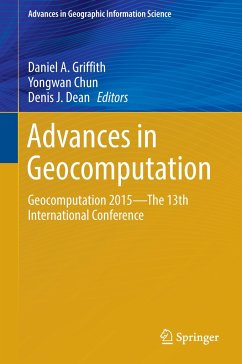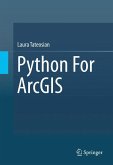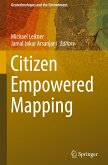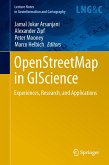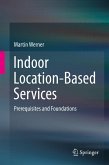Advances in Geocomputation
Geocomputation 2015--The 13th International Conference
Herausgegeben:Griffith, Daniel A.; Chun, Yongwan; Dean, Denis J.
Advances in Geocomputation
Geocomputation 2015--The 13th International Conference
Herausgegeben:Griffith, Daniel A.; Chun, Yongwan; Dean, Denis J.
- Gebundenes Buch
- Merkliste
- Auf die Merkliste
- Bewerten Bewerten
- Teilen
- Produkt teilen
- Produkterinnerung
- Produkterinnerung
This book contains refereed papers from the 13th International Conference on GeoComputation held at the University of Texas, Dallas, May 20-23, 2015. Since 1996, the members of the GeoComputation (the art and science of solving complex spatial problems with computers) community have joined together to develop a series of conferences in the United Kingdom, New Zealand, Australia, Ireland and the United States of America. The conference encourages diverse topics related to novel methodologies and technologies to enrich the future development of GeoComputation research.
Andere Kunden interessierten sich auch für
![Python For ArcGIS Python For ArcGIS]() Laura TateosianPython For ArcGIS82,99 €
Laura TateosianPython For ArcGIS82,99 €![Citizen Empowered Mapping Citizen Empowered Mapping]() Citizen Empowered Mapping112,99 €
Citizen Empowered Mapping112,99 €![Thermo-Hydro-Mechanical-Chemical Processes in Fractured Porous Media: Modelling and Benchmarking Thermo-Hydro-Mechanical-Chemical Processes in Fractured Porous Media: Modelling and Benchmarking]() Thermo-Hydro-Mechanical-Chemical Processes in Fractured Porous Media: Modelling and Benchmarking75,99 €
Thermo-Hydro-Mechanical-Chemical Processes in Fractured Porous Media: Modelling and Benchmarking75,99 €![OpenStreetMap in GIScience OpenStreetMap in GIScience]() OpenStreetMap in GIScience75,99 €
OpenStreetMap in GIScience75,99 €![Indoor Location-Based Services Indoor Location-Based Services]() Martin WernerIndoor Location-Based Services75,99 €
Martin WernerIndoor Location-Based Services75,99 €![Thermo-Hydro-Mechanical-Chemical Processes in Fractured Porous Media: Modelling and Benchmarking Thermo-Hydro-Mechanical-Chemical Processes in Fractured Porous Media: Modelling and Benchmarking]() Thermo-Hydro-Mechanical-Chemical Processes in Fractured Porous Media: Modelling and Benchmarking75,99 €
Thermo-Hydro-Mechanical-Chemical Processes in Fractured Porous Media: Modelling and Benchmarking75,99 €![Indoor Location-Based Services Indoor Location-Based Services]() Martin WernerIndoor Location-Based Services75,99 €
Martin WernerIndoor Location-Based Services75,99 €-
-
-
This book contains refereed papers from the 13th International Conference on GeoComputation held at the University of Texas, Dallas, May 20-23, 2015. Since 1996, the members of the GeoComputation (the art and science of solving complex spatial problems with computers) community have joined together to develop a series of conferences in the United Kingdom, New Zealand, Australia, Ireland and the United States of America. The conference encourages diverse topics related to novel methodologies and technologies to enrich the future development of GeoComputation research.
Produktdetails
- Produktdetails
- Advances in Geographic Information Science
- Verlag: Springer / Springer International Publishing / Springer, Berlin
- Artikelnr. des Verlages: 978-3-319-22785-6
- 1st ed. 2017
- Seitenzahl: 464
- Erscheinungstermin: 5. Januar 2017
- Englisch
- Abmessung: 241mm x 160mm x 31mm
- Gewicht: 874g
- ISBN-13: 9783319227856
- ISBN-10: 3319227858
- Artikelnr.: 43231924
- Herstellerkennzeichnung
- Springer-Verlag GmbH
- Tiergartenstr. 17
- 69121 Heidelberg
- ProductSafety@springernature.com
- Advances in Geographic Information Science
- Verlag: Springer / Springer International Publishing / Springer, Berlin
- Artikelnr. des Verlages: 978-3-319-22785-6
- 1st ed. 2017
- Seitenzahl: 464
- Erscheinungstermin: 5. Januar 2017
- Englisch
- Abmessung: 241mm x 160mm x 31mm
- Gewicht: 874g
- ISBN-13: 9783319227856
- ISBN-10: 3319227858
- Artikelnr.: 43231924
- Herstellerkennzeichnung
- Springer-Verlag GmbH
- Tiergartenstr. 17
- 69121 Heidelberg
- ProductSafety@springernature.com
Dr. Daniel A. Griffith is an Ashbel Smith Professor of Geospatial Information Sciences at the University of Texas at Dallas, chair of the International Spatial Accuracy Research Association (ISARA) Steering Committee, a Committee member of the International Geographical Union (IGU) Commission on Modeling Geographical Systems Steering, an elected Regional Science Association International (RSAI) Councilor, a two-appointment Fulbright Senior Specialist, and an elected fellow of the American Association for the Advancement of Science (AAAS), the American Statistical Association (ASA), the Spatial Econometrics Association, the RSAI, and the New York Academy of Sciences. He also is a former Guggenheim fellow, and has been awarded distinguish scholarship honors by the Association of American Geographers. Dr. Griffith has published nearly two dozen books and over 200 papers, and is a previous editor of Geographical Analysis. Dr. Yongwan Chun is an associate professor of Geospatial Information Sciences at the University of Texas at Dallas. His research interests lie in spatial statistics and GIS, focusing on urban issues concerning population movement, environment, health, and crime. His research has been supported by the US National Science Foundation and the US National Institutes of Health, among others. He has over 50 publications, including books, journal articles, book chapters, conference proceedings, and encyclopedia entries. He served on the Geocomputation (2015) and Spatial Statistics (2013) international conference organizing committees. Dr. Denis J. Dean is the Dean of the School of Economic, Political and Policy Sciences and a former Head of the Geospatial Information Sciences program at the University of Texas at Dallas. He has taught courses in spatial optimization, geospatial modeling and analysis,remote sensing, cartography, geodesy and other aspects of geospatial information sciences to students in North and South America, Europe and Asia. He has published over 75 papers on spatial optimization, accuracy assessment of common spatial analysis operators, and other areas of geospatial information science.
Preface.- Introduction.- The Nexus of Food, Energy, and Water Resources: Visions and Challenges in Spatial Computing.- The Bird
s-Eye View from a Worm
s-Eye Perspective.- Part I. Spatial Data: Construction, Representation, and Visualization.- High-Resolution Population Grids for the Entire Conterminous United States.- A Hybrid Dasymetric and Machine Learning Approach to High-Resolution Residential Electricity Consumption Modeling.- Can Social Media Play a Role in Developing Building Occupancy Curves?.- Application of Social Media Data to High Resolution Mapping of a Special Event Population.- Animating Maps: Visual Analytics Meets Geoweb 2.0.- Atvis: A New Transit Visualization System.- Mapping Spatiotemporal Patterns of Disabled People: The Case of the St. Jude
s Storm Emergency.- Terra Populus: Challenges and Opportunities with Heterogeneous Big Spatial Data.- Part II. Spatial Analysis: Methods and Applications.- A Deviation Flow Refueling Location Model for Continuous Space: A Commercial Drone Delivery System for Urban Areas.- Exploring the Spatial Decay Effect in Mass Media and Location-Based Social Media: A Case Study of China.- Uncovering the Digital Divide and the Physical Divide in Senegal Using Mobile Phone Data.- Predicting Hourly Ozone Pollution in the Dallas
Fort Worth Area Using Spatiotemporal Clustering.- Does the Location of Amerindian Communities Provide Signals about the Spatial Distribution of Tree and Palm Species?.- World Climate Search and Classification Using a Dynamic Time Warping Similarity Function.- Attribute Portfolio Distance: A Dynamic Time Warping-Based Approach to Comparing and Detecting Common Spatiotemporal Patterns among Multiattribute Data Portfolios.- When Space Beats Time: A Proof of Concept with Hurricane Dean.- Using Soft Computing Logic and the Logic Scoring of Preference Method for Agricultural Land Suitability Evaluation.- Surgical Phase Recognition Using Movement Data from Video Imagery and Location Sensor Data.- Part III. Spatial Statistical and Geostatistical Modeling.- Respondent Driven Sampling and Spatial Autocorrelation.- The Moran Coefficient and the Geary Ratio: Some mathematical and numerical comparisons.- A Variance-Stabilizing Transformation to Mitigate Biased Variogram Estimation in Heterogeneous Surfaces with Clustered Samples.- Estimating a Variance Function of a Nonstationary Process.- The Statistical Distribution of Coefficients for Constructing Eigenvector Spatial Filters.- Spatial Data Analysis Uncertainties Introduced by Selected Sources of Error.- Spatiotemporal Epidemic Modeling with libSpatialSEIR: Specification, Fitting, Selection, and Prediction.- Geostatistical Models for the Spatial Distribution of Uranium in the Continental United States.- Modeling Land Use Change Using an Eigenvector Spatial Filtering Model Specification for Discrete Responses.- Part IV. Computational Challenges and Advances in Geocomputation: High Performance Computation and Dynamic Simulation.- From Everywhere to Everywhere (FETE): Adaptation of a Pedestrian Movement Network Model to a Hybrid Parallel Environment.- Parallelizing Affinity Propagation Using Graphics Processing Units for Spatial Cluster Analysis over Big Geospatial Data.- A Web-Based Geographic Information Platform to Support Urban Adaptation to Climate Change.- A Fully Automated High-Performance Image Registration Work Flow to Support Precision Geolocation for Imagery Collected by Airborne and Spaceborne Sensors.- MIRAGE: A Framework for Data-driven Collaborative High-resolution Simulation.- A Graph-Based Locality-Aware Approach to Scalable Parallel Agent-Based Models of Spatial Interaction.- Simulation of Human Wayfinding Uncertainties: Operationalizing a Wandering Disutility Function.- Design and Validation of Dynamic Hierarchies and Adaptive Layouts Using Spatial Graph Grammars.
s-Eye View from a Worm
s-Eye Perspective.- Part I. Spatial Data: Construction, Representation, and Visualization.- High-Resolution Population Grids for the Entire Conterminous United States.- A Hybrid Dasymetric and Machine Learning Approach to High-Resolution Residential Electricity Consumption Modeling.- Can Social Media Play a Role in Developing Building Occupancy Curves?.- Application of Social Media Data to High Resolution Mapping of a Special Event Population.- Animating Maps: Visual Analytics Meets Geoweb 2.0.- Atvis: A New Transit Visualization System.- Mapping Spatiotemporal Patterns of Disabled People: The Case of the St. Jude
s Storm Emergency.- Terra Populus: Challenges and Opportunities with Heterogeneous Big Spatial Data.- Part II. Spatial Analysis: Methods and Applications.- A Deviation Flow Refueling Location Model for Continuous Space: A Commercial Drone Delivery System for Urban Areas.- Exploring the Spatial Decay Effect in Mass Media and Location-Based Social Media: A Case Study of China.- Uncovering the Digital Divide and the Physical Divide in Senegal Using Mobile Phone Data.- Predicting Hourly Ozone Pollution in the Dallas
Fort Worth Area Using Spatiotemporal Clustering.- Does the Location of Amerindian Communities Provide Signals about the Spatial Distribution of Tree and Palm Species?.- World Climate Search and Classification Using a Dynamic Time Warping Similarity Function.- Attribute Portfolio Distance: A Dynamic Time Warping-Based Approach to Comparing and Detecting Common Spatiotemporal Patterns among Multiattribute Data Portfolios.- When Space Beats Time: A Proof of Concept with Hurricane Dean.- Using Soft Computing Logic and the Logic Scoring of Preference Method for Agricultural Land Suitability Evaluation.- Surgical Phase Recognition Using Movement Data from Video Imagery and Location Sensor Data.- Part III. Spatial Statistical and Geostatistical Modeling.- Respondent Driven Sampling and Spatial Autocorrelation.- The Moran Coefficient and the Geary Ratio: Some mathematical and numerical comparisons.- A Variance-Stabilizing Transformation to Mitigate Biased Variogram Estimation in Heterogeneous Surfaces with Clustered Samples.- Estimating a Variance Function of a Nonstationary Process.- The Statistical Distribution of Coefficients for Constructing Eigenvector Spatial Filters.- Spatial Data Analysis Uncertainties Introduced by Selected Sources of Error.- Spatiotemporal Epidemic Modeling with libSpatialSEIR: Specification, Fitting, Selection, and Prediction.- Geostatistical Models for the Spatial Distribution of Uranium in the Continental United States.- Modeling Land Use Change Using an Eigenvector Spatial Filtering Model Specification for Discrete Responses.- Part IV. Computational Challenges and Advances in Geocomputation: High Performance Computation and Dynamic Simulation.- From Everywhere to Everywhere (FETE): Adaptation of a Pedestrian Movement Network Model to a Hybrid Parallel Environment.- Parallelizing Affinity Propagation Using Graphics Processing Units for Spatial Cluster Analysis over Big Geospatial Data.- A Web-Based Geographic Information Platform to Support Urban Adaptation to Climate Change.- A Fully Automated High-Performance Image Registration Work Flow to Support Precision Geolocation for Imagery Collected by Airborne and Spaceborne Sensors.- MIRAGE: A Framework for Data-driven Collaborative High-resolution Simulation.- A Graph-Based Locality-Aware Approach to Scalable Parallel Agent-Based Models of Spatial Interaction.- Simulation of Human Wayfinding Uncertainties: Operationalizing a Wandering Disutility Function.- Design and Validation of Dynamic Hierarchies and Adaptive Layouts Using Spatial Graph Grammars.
Preface.- Introduction.- The Nexus of Food, Energy, and Water Resources: Visions and Challenges in Spatial Computing.- The Bird
s-Eye View from a Worm
s-Eye Perspective.- Part I. Spatial Data: Construction, Representation, and Visualization.- High-Resolution Population Grids for the Entire Conterminous United States.- A Hybrid Dasymetric and Machine Learning Approach to High-Resolution Residential Electricity Consumption Modeling.- Can Social Media Play a Role in Developing Building Occupancy Curves?.- Application of Social Media Data to High Resolution Mapping of a Special Event Population.- Animating Maps: Visual Analytics Meets Geoweb 2.0.- Atvis: A New Transit Visualization System.- Mapping Spatiotemporal Patterns of Disabled People: The Case of the St. Jude
s Storm Emergency.- Terra Populus: Challenges and Opportunities with Heterogeneous Big Spatial Data.- Part II. Spatial Analysis: Methods and Applications.- A Deviation Flow Refueling Location Model for Continuous Space: A Commercial Drone Delivery System for Urban Areas.- Exploring the Spatial Decay Effect in Mass Media and Location-Based Social Media: A Case Study of China.- Uncovering the Digital Divide and the Physical Divide in Senegal Using Mobile Phone Data.- Predicting Hourly Ozone Pollution in the Dallas
Fort Worth Area Using Spatiotemporal Clustering.- Does the Location of Amerindian Communities Provide Signals about the Spatial Distribution of Tree and Palm Species?.- World Climate Search and Classification Using a Dynamic Time Warping Similarity Function.- Attribute Portfolio Distance: A Dynamic Time Warping-Based Approach to Comparing and Detecting Common Spatiotemporal Patterns among Multiattribute Data Portfolios.- When Space Beats Time: A Proof of Concept with Hurricane Dean.- Using Soft Computing Logic and the Logic Scoring of Preference Method for Agricultural Land Suitability Evaluation.- Surgical Phase Recognition Using Movement Data from Video Imagery and Location Sensor Data.- Part III. Spatial Statistical and Geostatistical Modeling.- Respondent Driven Sampling and Spatial Autocorrelation.- The Moran Coefficient and the Geary Ratio: Some mathematical and numerical comparisons.- A Variance-Stabilizing Transformation to Mitigate Biased Variogram Estimation in Heterogeneous Surfaces with Clustered Samples.- Estimating a Variance Function of a Nonstationary Process.- The Statistical Distribution of Coefficients for Constructing Eigenvector Spatial Filters.- Spatial Data Analysis Uncertainties Introduced by Selected Sources of Error.- Spatiotemporal Epidemic Modeling with libSpatialSEIR: Specification, Fitting, Selection, and Prediction.- Geostatistical Models for the Spatial Distribution of Uranium in the Continental United States.- Modeling Land Use Change Using an Eigenvector Spatial Filtering Model Specification for Discrete Responses.- Part IV. Computational Challenges and Advances in Geocomputation: High Performance Computation and Dynamic Simulation.- From Everywhere to Everywhere (FETE): Adaptation of a Pedestrian Movement Network Model to a Hybrid Parallel Environment.- Parallelizing Affinity Propagation Using Graphics Processing Units for Spatial Cluster Analysis over Big Geospatial Data.- A Web-Based Geographic Information Platform to Support Urban Adaptation to Climate Change.- A Fully Automated High-Performance Image Registration Work Flow to Support Precision Geolocation for Imagery Collected by Airborne and Spaceborne Sensors.- MIRAGE: A Framework for Data-driven Collaborative High-resolution Simulation.- A Graph-Based Locality-Aware Approach to Scalable Parallel Agent-Based Models of Spatial Interaction.- Simulation of Human Wayfinding Uncertainties: Operationalizing a Wandering Disutility Function.- Design and Validation of Dynamic Hierarchies and Adaptive Layouts Using Spatial Graph Grammars.
s-Eye View from a Worm
s-Eye Perspective.- Part I. Spatial Data: Construction, Representation, and Visualization.- High-Resolution Population Grids for the Entire Conterminous United States.- A Hybrid Dasymetric and Machine Learning Approach to High-Resolution Residential Electricity Consumption Modeling.- Can Social Media Play a Role in Developing Building Occupancy Curves?.- Application of Social Media Data to High Resolution Mapping of a Special Event Population.- Animating Maps: Visual Analytics Meets Geoweb 2.0.- Atvis: A New Transit Visualization System.- Mapping Spatiotemporal Patterns of Disabled People: The Case of the St. Jude
s Storm Emergency.- Terra Populus: Challenges and Opportunities with Heterogeneous Big Spatial Data.- Part II. Spatial Analysis: Methods and Applications.- A Deviation Flow Refueling Location Model for Continuous Space: A Commercial Drone Delivery System for Urban Areas.- Exploring the Spatial Decay Effect in Mass Media and Location-Based Social Media: A Case Study of China.- Uncovering the Digital Divide and the Physical Divide in Senegal Using Mobile Phone Data.- Predicting Hourly Ozone Pollution in the Dallas
Fort Worth Area Using Spatiotemporal Clustering.- Does the Location of Amerindian Communities Provide Signals about the Spatial Distribution of Tree and Palm Species?.- World Climate Search and Classification Using a Dynamic Time Warping Similarity Function.- Attribute Portfolio Distance: A Dynamic Time Warping-Based Approach to Comparing and Detecting Common Spatiotemporal Patterns among Multiattribute Data Portfolios.- When Space Beats Time: A Proof of Concept with Hurricane Dean.- Using Soft Computing Logic and the Logic Scoring of Preference Method for Agricultural Land Suitability Evaluation.- Surgical Phase Recognition Using Movement Data from Video Imagery and Location Sensor Data.- Part III. Spatial Statistical and Geostatistical Modeling.- Respondent Driven Sampling and Spatial Autocorrelation.- The Moran Coefficient and the Geary Ratio: Some mathematical and numerical comparisons.- A Variance-Stabilizing Transformation to Mitigate Biased Variogram Estimation in Heterogeneous Surfaces with Clustered Samples.- Estimating a Variance Function of a Nonstationary Process.- The Statistical Distribution of Coefficients for Constructing Eigenvector Spatial Filters.- Spatial Data Analysis Uncertainties Introduced by Selected Sources of Error.- Spatiotemporal Epidemic Modeling with libSpatialSEIR: Specification, Fitting, Selection, and Prediction.- Geostatistical Models for the Spatial Distribution of Uranium in the Continental United States.- Modeling Land Use Change Using an Eigenvector Spatial Filtering Model Specification for Discrete Responses.- Part IV. Computational Challenges and Advances in Geocomputation: High Performance Computation and Dynamic Simulation.- From Everywhere to Everywhere (FETE): Adaptation of a Pedestrian Movement Network Model to a Hybrid Parallel Environment.- Parallelizing Affinity Propagation Using Graphics Processing Units for Spatial Cluster Analysis over Big Geospatial Data.- A Web-Based Geographic Information Platform to Support Urban Adaptation to Climate Change.- A Fully Automated High-Performance Image Registration Work Flow to Support Precision Geolocation for Imagery Collected by Airborne and Spaceborne Sensors.- MIRAGE: A Framework for Data-driven Collaborative High-resolution Simulation.- A Graph-Based Locality-Aware Approach to Scalable Parallel Agent-Based Models of Spatial Interaction.- Simulation of Human Wayfinding Uncertainties: Operationalizing a Wandering Disutility Function.- Design and Validation of Dynamic Hierarchies and Adaptive Layouts Using Spatial Graph Grammars.

